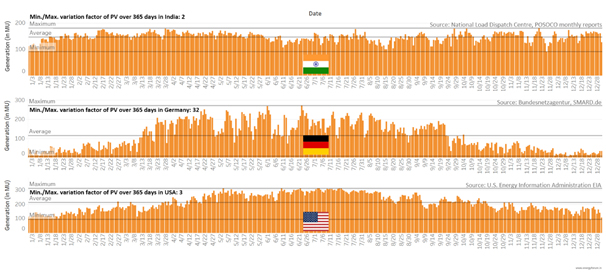16 July 2021
Global Markets
Agro-photovoltaics: India’s spot of eternal sunshine
Somewhere in India, the sun is always shining, especially on its vast reserves of agricultural land. Tobias Winter, Director, Indo-German Energy Forum, builds up a compelling case for unravelling the magic of Agro-photovoltaics -- the technique of using the same patch of land for growing crops and generating electricity
 Before delving into Agro-photovoltaics -- the emerging field of using the same agricultural tract for growing crops and generating electricity -- it is important to understand how much solar generation can India actually bank on? The answer: India can count on one of the highest solar energy security rates in the world.
Before delving into Agro-photovoltaics -- the emerging field of using the same agricultural tract for growing crops and generating electricity -- it is important to understand how much solar generation can India actually bank on? The answer: India can count on one of the highest solar energy security rates in the world.
The latest analysis on actual solar generation of solar power plants in India confirms, that solar generation is evenly distributed throughout the entire year in India. In 2020 there were only a few days where the national solar generation dropped to around 50 % compared to the record solar generation on the 21st of Nov. 2020. As a comparative analysis, for instance, In Germany the solar generation can drop down to 3 % of its maximum for several days in the year. This is a huge global competitive advantage for India.
With the nation already implementing the concept of ‘One Nation - One Grid, 365 days of Solar Generation’, no long-term storage solutions are required in the country. The focus could shift on harnessing yet another of its invaluable resource – the vast tracts of agricultural land. Agro-photovoltaics can combine the abundance of both by installing semi-transparent solar panels at sufficient height from the ground using taller mounting frames so that crops can be grown in that space.
365 days of solar photovoltaic (PV) generation in India, Germany and USA in the year 2020. Data available here.

Leveraging the combined potential of India’s solar power and agricultural lands
Agriculture requires land and abundance of sunshine -- the same resources that are required by solar panels for green energy generation. Here again, agro-photovoltaics in India have an advantage given the fact, that the shading effect of solar panels from the harsh sunlight has proven beneficial for plant growth. Correspondingly in Europe, the shading effect of solar panels may slightly reduce the agricultural yield due to less sunshine.
Installing elevated solar panels and allowing the plantation of cash crops to grow below, between and around the panel arrays can providing a dual source of revenue -- the Indian fields can generate a surplus of green energy as well as fresh greens simultaneously! Currently, the first test trials in India are even experimenting with vertically mounted bi-facial solar panels. Renowned Indian research institutes such as CAZRI and NISE and Universities of Junagadh, Dayalbagh and Amity have demonstrated the beneficial effect of solar combined with agriculture.
The Indo-German Energy Forum would also like to congratulate the National Solar Energy Federation of India for having published an innovative interactive map with India’s Agro-photovoltaic pilots along with relevant information available here. Multinationals like Jain Irrigation, BayWa and Shell, just to name a few, are keeping a close watch on the recent developments.
The New Green Revolution?
Helpful global research data on the Agro PV potential exists. For instance, according to a German study, 1 hectare of land covered by Agro-photovoltaics in India, can allow an electric car to drive around 21 times more kilometers than with a combustion engine car using biofuels produced on the same amount of land. In the US, studies are now analysing where to strategically place Agro PV models to double up as charging stations for electric vehicles on national highways.
The Ministry of New and Renewable Energy (MNRE) in India had commissioned a study on Agro-photovoltaics in India to the German research institute Fraunhofer, that recently shared some insights of its preliminary findings with the Indo-German Energy Forum. According to it, just 1% of India’s agricultural land can provide 629.7 GWp through the adoption of Agro-photovoltaics. Taking into account the estimates for future electricity demand by the International Energy Agency (IEA) this capacity would be sufficient to cover around 1/3 of India’s entire electricity demand by the year 2040.
With a basket of inherent advantages, India might well be staring at an Agro-photovoltaic Revolution, stealing the thunder from new technologies such as bifacial modules, monoline single axis tracking and cabling, and rail-less solar powered robotic dry-cleaning systems, already in use commercially.